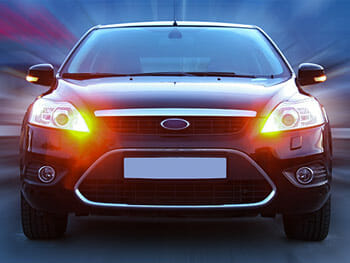
We’re barely past the Winter Solstice, the shortest day of the year. On January 30, Baltimore will have only 10 hours of daylight, and even by the end of the first quarter that will increase to only 12.5 hours. That means a lot of us are likely to be doing most of our driving in low-light situations – dusk, dawn and night – when accidents are most likely to occur.
Statistics from the National Highway Traffic Safety Administration (NHTSA) reflect the increased risk of nighttime driving, showing that almost half (49%) of passenger vehicle occupant fatalities occur during nighttime, and the after-dark fatality rate is about three times higher per vehicle mile of travel.
Several factors are likely at play in the hazardous nature of nighttime driving:
1. Fatigue at the end of a workday
2. A higher incidence of alcohol use at night
3. Physiology, i.e., depth perception, color recognition, and peripheral vision are compromised after sundown.
Additionally, when a vehicle is not optimally maintained, the driver may be unable to see as well as he or she should.
The Thing About High Beams…
Typical low beams illuminate the road from 160 to 250 feet in front of a car, and normal high beams shine from about 350 to 500 feet. A vehicle going 60 mph takes more than 200 feet to stop, so you can see that even a driver who has the high beams on doesn’t have much room for error or time to react. Through the years, various new developments have helped reduce nighttime fatalities – things like retroreflective materials in signs and highway markings.
The Future of Headlights
Headlights themselves continue to benefit from advancing technology. At the recent Consumer Electronics Show in Las Vegas, BMW revealed their new lighting concept for the M4. Headlights boosted by laser technology illuminate nearly 2,000 feet ahead of the vehicle, with light ten times more intense than xenon, halogen, or LED headlights. The system can also block out the high beams of cars coming toward you and use an infrared camera to detect and throw a spotlight on any pedestrians, animals or hazards that could enter your path. Sensors can even dim just a portion of the headlights’ beam so that it doesn’t blind oncoming vehicles. But don’t get too excited about this invention just yet – our federal vehicle-lighting standards will have to be updated before cars with the responsive laser lights are allowed on U.S. roads.
Getting Home Safe
In the meantime, there are a number of steps the average driver can take to make nighttime driving less hazardous:
- Keep the headlights, taillights, and signal lights clean. Mud spatters, winter slush and highway deicers can collect on the lights and impair your vision as well as the ability of other drivers to see and avoid you.
- Have your headlights properly aimed. Yes, they can get out of whack, with one beam pointing straight ahead and the other aimed somewhere off to the side.
- Don’t overdrive your headlights. Overdriving the headlights means driving too fast to be able to stop in the distance lit by your headlights.
- Start observing night driving safety measures before it gets totally dark. The time between sunset and nightfall is one of the most difficult times to drive, because your eyes are constantly adapting to the growing darkness.
- Avoid smoking inside the vehicle. Cigarette smoke leaves a film on the glass, contributing to glare as light refracts off the dirt.
- Regularly wash the inside of the windshield to remove haze caused by “plasticizer migration.” Various chemicals are incorporated into plastics to make them moldable, flexible and durable. Vinyl floor mats, seat covers, dashboards, instrument panel components and interior trim is likely to contain plasticizers. Over time and with exposure to the sun, the plasticizers escape in gaseous form, creating a cloudy deposit on windows. (By the way, it’s plasticizers which give your new ride that luxurious “new car smell.”)
- If you have an older car, it might have plastic lens covers on the headlamps which have yellowed over the years. You can buy a headlight polish kit to remove the haze so your lights shine through brightly.
- Use the dashboard dimmer switch to keep dash lights at less than maximum illumination.
- Don’t look directly at oncoming high beams. Instead, focus on the right side of the road, near the white line.
- If your vehicle doesn’t automatically make the adjustment for you, be sure to switch your inside rear-view mirror to the nighttime setting to decrease glare.
- Get regular vision checkups, especially as you get older. According to the National Safety Council (NSC), a 50-year-old driver may need twice as much light to see as well as the average 30-year-old. Conditions such as cataracts and diabetes may affect a person’s ability to drive at night. And sometimes the vision of those who have had LASIK eye surgery becomes distorted by halos and glare.
Drivers who fail to exercise due caution and/or properly maintain their vehicle can be held liable in a personal injury action. If you or your loved one was injured in a nighttime accident, the negligence of another driver may entitle you to compensation. Steve Heisler offers victims of Baltimore accidents both compassion and competence. He’d like to help you. Call (410) 625-4878.
